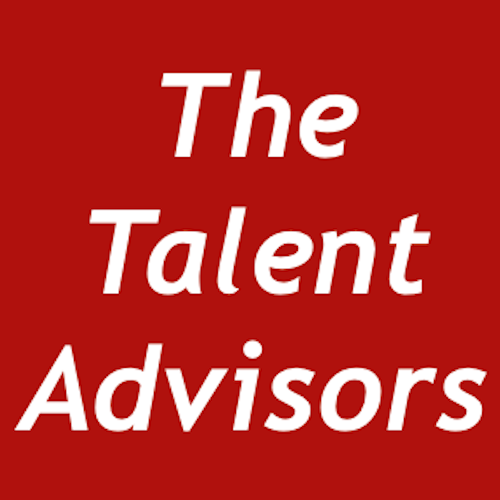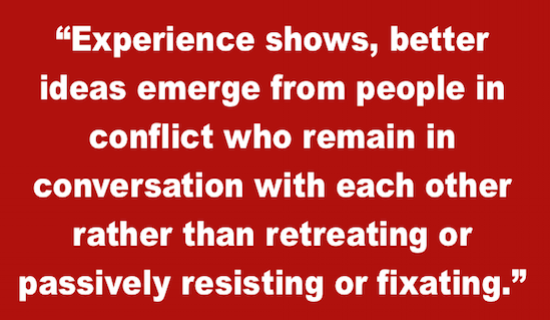CONFLICT, EMPATHY AND OPPORTUNITY
This article is part of our Insights For Action series. Join the mailing list to receive this and more.
Embrace different points of view and opinions >>
To execute strategy there needs a fine balance of constructive competition between some functions and aligned cooperation connecting others.
Strong views and opinions are part of what gets you into the executive suite. An executive’s ability to construct the right degree of tension on one hand with synergy and followership on the other is often tested. The difficulty is to shape an environment that is safe enough to promote difference and give a voice to silent questions, but intense enough to create high-performance. One of robust, decision-making, with unified decision taking. Where the silos and boundaries don’t work against the organisation.
The tone resonates from the top. While homogeneous teams may be easier to manage, diversity of thought and experience is highly advantageous. The senior team then needs to work together, disagreeing when necessary but resolving those differences to design and deliver coherent, effective strategies. Of course, it helps when people know and recognise how intellectual and interpersonal conflict differ.
In high-trust cultures, people may debate rigorously, but they also cooperate with each other easily, viewing others as equal partners who readily commit to the best overall future. Intellectual depth, breadth and ingenuity are fostered. If divisional power-interests or turf wars dominate, then directive clout stifles collegiality and heightens combativeness.
Conflict must be deflected from the important. Some business problems or opportunities are just too complex, difficult or ambiguous. Often no one individual or group can develop the answer, or if they could, they cannot execute on their own. To deal with and think through each layer of this complexity, a cross-divisional team must do more than navigate the solid and dotted lines. It has to accept shared accountability; knowing if the team fails, each member also fails.
Tension is a state of change. My observations when talking to executives during leader reviews or coaching sessions are that there are eight underlying sources of conflict:
Values: what is believed about culture, ethics and trust
Power: how control, authority and privilege play out
Structural: how we are organised and kept apart
Identity: who we are
Goal: what we are doing
Role: who is doing what
Style: way people do things
Procedural: how we are doing this.
Emotion also plays a considerable dynamic. Collaborative effort is a social process that requires give and take to develop conscious interdependence.
In Harper Lee’s 'To Kill a Mockingbird', Atticus tells his daughter Scout, ‘You never really understand a person until you consider things from his point of view… until you climb in his skin and walk around in it.’
Executives who display traits of high-collaboration, empathy and trust become better leaders, more effective cross-divisional contributors and sought-after mentors.
Whenever conflict begins to take a toll, coaching techniques using the Four-Step Framework outlined below can develop new skills in holding meaningful conversations, reframing assumptions and learning to fight the right fights in the right way. It can be transformative.
When conflict isn’t addressed, it takes on a life of its own, with sides emerging, focus diverted, wrong fights battled, tactics becoming destructive and the pushing of competitive bias.
“Some of the most creative ideas come out of people in conflict remaining in conversation with one another rather than retreating or staking out entrenched positions.” (Ronald Heifetz and Marty Linsky)
Successful leaders don’t shy away from or suppress differences with other people. The challenge is to develop structures and processes by which this conflict can be orchestrated productively. What reduces the anxiety of differing opinions?
People learn by engaging with a different point of view. When executives are passionate or forceful about their particular viewpoints, it generates ‘heat.’ Many leaders in these conflict situations are hostages to their fears and negative emotions, failing to see the opportunities.
Learning to put the matter on the table by using reflective thinking, reaching out strategically, stakeholder mapping and targeting communication can develop workable solutions.
Think of a person you are in conflict with. Then work through these steps and coaching questions:
Go To The Balcony
Step back and watch the conflict from the ‘balcony’ or ‘outside.’ Describe it.
If a third person would view the conflict, what would they see?
Can you name the causes?
What would need to be different for the conflict to be less?
What would provide safety, trust and respect?
What do you gain or lose by the conflict continuing?
Confirm Beliefs
What does this person believe about you?
What do you believe about the person?
What are the pros and cons of the other person’s view?
How do your emotions and hot buttons differ?
How do your leadership styles or preferences differ?
Reframe Around Common Goals
What do you have in common?
Which issues can form bonds or reciprocation?
What patterns emerge when you brainstorm various scenarios or solutions?
Look for ways to redefine the issue or create an alternative focus.
Look For A Third Position
Is there a third or more neutral side?
What are the pros and cons of a third view?
How can you shift mutual energies to support another stakeholder?
Not every conflict can be solved fully, but leaders who are adaptable and flexible can make adjustments for more satisfactory outcomes and feel less anxious.
_______________________
Copyright and All Rights Reserved | About Dianne Jacobs

